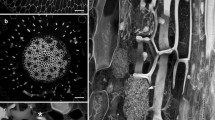Abstract
Differences in plasmodesmatal organization and frequency between cells which have and have not undergone wall expansion, were studied in four plant species (Trifolium repens L., Raphanus sativus L., Zea mays L., Sorghum vulgare L.). Plasmodesmatal disposition ranged from single dispersed to clustered into primary pit-fields. As the result of wall expansion (i.e. by comparing meristematic and elongate cells) there is a general shift from dispersed to clustered plasmodesmata. Plasmodesmatal frequency over the cell surface (number/μm2) does not decline as the result of wall expansion and cell elongation, thus indicating that secondary formation of plasmodesmata is a naturally occurring process during cell elongation, its extent being highest in Zea mays and lowest in Trifolium repens. The concurrent increases in frequency and clustering of plasmodesmata indicate that secondary formation may primarily occur in close proximity to pre-existing plasmodesmata.
Similar content being viewed by others
References
Burgess, J. (1971) Observations on structure and differentiation in plasmodesmata. Protoplasma 73, 83–95
Clowes, F.A.L., Juniper, B.E. (1968) Plasmodesmata in plant cells. In: Plant cells, pp. 256–269. Blackwell Scientific Publications, Oxford, UK
Esau, K. (1960) Anatomy of seed plants. John Wiley and Sons, New York
Gunning, B.E.S. (1978) Age-related and origin-related control of the numbers of plasmodesmata in cell walls of developing Azolla roots. Planta 143, 181–190
Jones, M.G.K. (1976) The origin and development of plasmodesmata. In: Intercellular communication in plants: Studies on plasmodesmata, pp. 81–103, Gunning, B.E.S., Robards, A.W., eds. Springer, Berlin Heidelberg New York
Juniper, B.E. (1977) Some speculations on the possible roles of the plasmodesmata in the control of differentiation. J. Theor. Biol. 66, 83–592
Juniper, B.E., Barlow P.W. (1969) The distribution of plasmodesmata in the root tip of maize. Planta 89, 352–360
Scott, F.M., Hamner, K.C., Baker, E., Bawler, E. (1956) Electron microscope studies of cell wall growth in the onion root. Am. J. Bot. 43, 313–324
Seagull, R.W. (1983) The role of the cytoskeleton during oriented microfibril deposition. I. Elucidation of the possible interaction between microtubules and cellulose synthetic complexes. J. Ultrastruct. Res. 83, 168–175
Spurr, A.R. (1969) A low viscosity epoxy resin embedding medium for electron microscopy. J. Ultrastruct. Res. 26, 31
Thorpe, J.R., Harvey, D.M.R. (1979) Optimization and investigation of the use of 2,2-dimethoxypropane as a dehydration agent for plant tissues in transmission electron microscopy. J. Ultrastruct. Res. 68, 186–194
Author information
Authors and Affiliations
Rights and permissions
About this article
Cite this article
Seagull, R.W. Differences in the frequency and disposition of plasmodesmata resulting from root cell elongation. Planta 159, 497–504 (1983). https://doi.org/10.1007/BF00409138
Received:
Accepted:
Issue Date:
DOI: https://doi.org/10.1007/BF00409138




